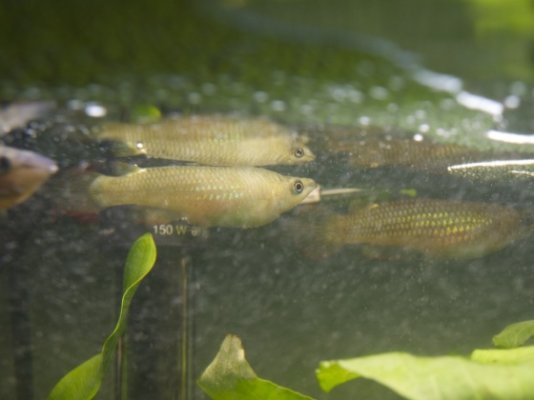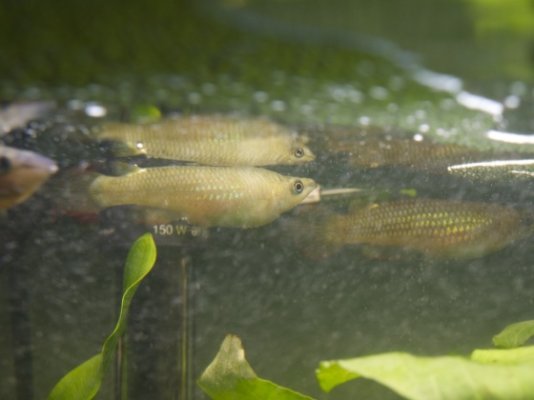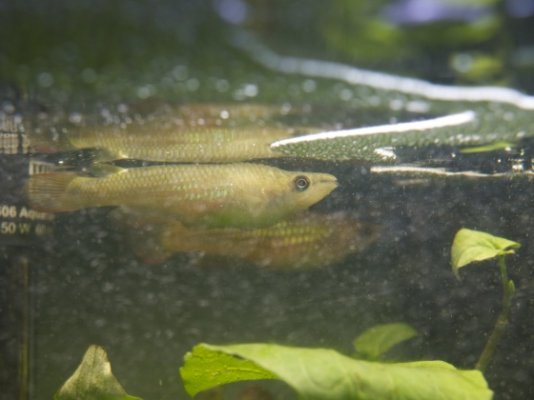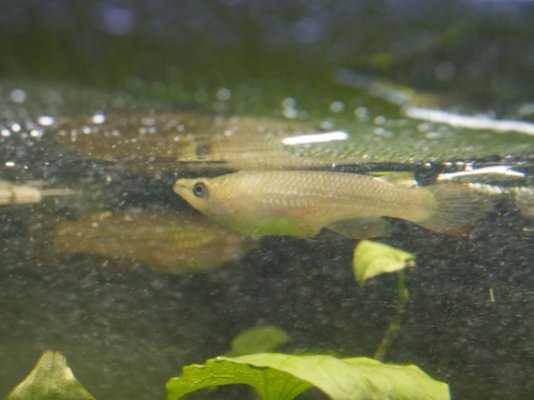here are the answers to the questions:
1~What type of fish is afflicted? In addition, please describe what is wrong with the fish to the best of your ability (i.e. cotton like growth, bloated, etc.).
a female golden killie. the problems are: rapid breathing, no appetite, protruding scales around all around the first 1/3 of the fish (mouth to pectorial fins)
2~What are your tank parameters (ammonia, nitrites, nitrates, temp, pH)? Please give exact values.
the total ammonia is around 1ppm. however, since the pH is low @ around 6, the free ammonia is almost negligible. nitrites and nitrates, according to the test strips are close to 0ppm. the pH is an issue. it is usually at or below 6, and with water changes it comes up to about 6.6, but then drops to 6 or below through the night. the temp hovers between 78-84F depending on the time of day/night.
3~ How large is the tank? How long has the tank been set up?
the tank is a 29 gallon tank. it's been setup for about 3-4 weeks.
4~What type of filtration are you using? Please give the name and number (i.e. Fluval 304) and amount of gph if known.
i have two filters. one is a marineland penguin biowheel 200 , which filters & 200gph. the other filter is a powerhead with a large sponge. i don't know the specs on the powerhead.
5~How many fish are in the tank? What kinds of fish are they and what are their current sizes?
there are 5 golden killies (2 male adults, 3 female adults), 4 silver angelfish (1 male adult, 3 unknown juvenile), 1 opaline gourami (male adult), 1 feeder goldfish (unknown ~2")
6~When is the last time you did a water change and vacuum the gravel? How often do you do this? How much water do you remove at a time?
i haven't started the gravel vacuuming yet. i usually change around 15-20% of the water. i've slowed it to every 3rd or 4th day.
7~How long have you had the fish? If the fish is new, how did you acclimate it/them?
i've had them for almost 8-9 months. i had them back when i was in jersey, and i had them transported from jersey to california about 3-4 weeks ago. unfortunately, i could have done a better job of acclimating them. they weren't shipped in the best conditions, so i was more worried that they needed some warm clean water.
8~Have you added anything new to the tank--decor, new dechlorinator, new substrate, etc.?
the tap water here has a high pH of about 8.4 and was well buffered with a kH of about 150-180ppm. not knowing better, and stressing because the water back in jersey (princeton) was at a neutral 7 with no buffering, i went out and bought seachem's acid buffer. what a distaster. since i added a small amount, i can not get the pH to rise and stay at a higher level, no matter how much water i've changed. the aquarium is moderately planted. i'm using seachem's flourite as my only gravel/substrate source.
i use kordon's amquel+ and novaaqua+, along with seachem's stability to prime the water and get the biological filter going. since the fish started to show signs of lethargy, i add a dosage of melafix and pima fix nightly.
9~What kind of food have you been feeding your fish, have you changed their diet recently?
i feed them tetra's tropical crisps 2x day. i also feed them some crushed alge discs, and the occasional freeze dried brine shrimp, freeze dried krill, and frozen bloodworms.
----------
i noticed this fish breathing rapidly about a week back which is when i started the pimafix/melafix. today, i noticed she had protruding scales.
unfortunately, i have never had any success with successfully treating fish, so i'm at a loss. i don't want to lose the fish, so someone please help me out with what i outta do. i'm going to get a small quarantine tank tomorrow to isolate and treat the fish, but i have no idea what i i should use to treat the fish.
1~What type of fish is afflicted? In addition, please describe what is wrong with the fish to the best of your ability (i.e. cotton like growth, bloated, etc.).
a female golden killie. the problems are: rapid breathing, no appetite, protruding scales around all around the first 1/3 of the fish (mouth to pectorial fins)
2~What are your tank parameters (ammonia, nitrites, nitrates, temp, pH)? Please give exact values.
the total ammonia is around 1ppm. however, since the pH is low @ around 6, the free ammonia is almost negligible. nitrites and nitrates, according to the test strips are close to 0ppm. the pH is an issue. it is usually at or below 6, and with water changes it comes up to about 6.6, but then drops to 6 or below through the night. the temp hovers between 78-84F depending on the time of day/night.
3~ How large is the tank? How long has the tank been set up?
the tank is a 29 gallon tank. it's been setup for about 3-4 weeks.
4~What type of filtration are you using? Please give the name and number (i.e. Fluval 304) and amount of gph if known.
i have two filters. one is a marineland penguin biowheel 200 , which filters & 200gph. the other filter is a powerhead with a large sponge. i don't know the specs on the powerhead.
5~How many fish are in the tank? What kinds of fish are they and what are their current sizes?
there are 5 golden killies (2 male adults, 3 female adults), 4 silver angelfish (1 male adult, 3 unknown juvenile), 1 opaline gourami (male adult), 1 feeder goldfish (unknown ~2")
6~When is the last time you did a water change and vacuum the gravel? How often do you do this? How much water do you remove at a time?
i haven't started the gravel vacuuming yet. i usually change around 15-20% of the water. i've slowed it to every 3rd or 4th day.
7~How long have you had the fish? If the fish is new, how did you acclimate it/them?
i've had them for almost 8-9 months. i had them back when i was in jersey, and i had them transported from jersey to california about 3-4 weeks ago. unfortunately, i could have done a better job of acclimating them. they weren't shipped in the best conditions, so i was more worried that they needed some warm clean water.
8~Have you added anything new to the tank--decor, new dechlorinator, new substrate, etc.?
the tap water here has a high pH of about 8.4 and was well buffered with a kH of about 150-180ppm. not knowing better, and stressing because the water back in jersey (princeton) was at a neutral 7 with no buffering, i went out and bought seachem's acid buffer. what a distaster. since i added a small amount, i can not get the pH to rise and stay at a higher level, no matter how much water i've changed. the aquarium is moderately planted. i'm using seachem's flourite as my only gravel/substrate source.
i use kordon's amquel+ and novaaqua+, along with seachem's stability to prime the water and get the biological filter going. since the fish started to show signs of lethargy, i add a dosage of melafix and pima fix nightly.
9~What kind of food have you been feeding your fish, have you changed their diet recently?
i feed them tetra's tropical crisps 2x day. i also feed them some crushed alge discs, and the occasional freeze dried brine shrimp, freeze dried krill, and frozen bloodworms.
----------
i noticed this fish breathing rapidly about a week back which is when i started the pimafix/melafix. today, i noticed she had protruding scales.
unfortunately, i have never had any success with successfully treating fish, so i'm at a loss. i don't want to lose the fish, so someone please help me out with what i outta do. i'm going to get a small quarantine tank tomorrow to isolate and treat the fish, but i have no idea what i i should use to treat the fish.
Last edited:





